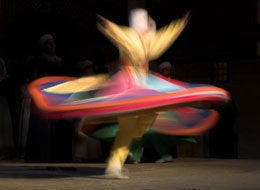
When I was 5, I could fly. That was an age when I soared in a boundless, timeless openness. I experienced infinity on my stairwell with the tiled linoleum as I flew back and forth, up and down the stairs, in a small house, in a small town, in Indiana in the 60s. In hindsight, I was in a state of being so in tune with my surroundings that I knew no bounds. I remember flying in the backseat of our sea green Ford. Our car would hover at a red light and I could become the girl in the backseat of an adjacent car, or a boy, or a man or an old woman, and for a moment, I would be them - seeing from their eyes, interconnected with them, feeling their pain or happiness, or just seeing the red light from their perspective. But a girl of 5 can't fly - or tell others she flies.
So I stopped flying and forgot I ever could. In later age, I discovered it again. But now I see my experiences with 'flight' as metaphysical experiences, experiences of 'self-transcendence', 'intuition', or 'mysticism'.
Mysticism is the access of knowledge through meta-physical experience.
Intuition is the access of knowledge through non-rational means.
Spirituality is access to knowledge through a non-scientific methodology.
These are three different ways of saying the same thing and reflect the challenge of describing 'spiritual' 'mystical' or 'metaphysical' experiences in a language of science and reason.
Secularists following a material reductionist model of science see mysticism as a manifestation of a physical brain state; spiritualists see mysticism as a relationship with God or the universe. Yet mysticism may be both - an experience with corresponding physical brain correlates and an experience of relationship to the universe at large. Quantum physics is providing a clue as to how relationship can influence physical reality at the quantum level of neurobiology and consciousness (see Mindful Universe by Stapp).
Jonas Salk saw metaphysical evolution as the next phase of human evolution.
Dr. Jill Bolte Taylor, a neuroanatomist at Indiana University had a mystical experience brought about when a left hemisphere brain hemorrhage shattered her self-oriented view of the universe (see www.TED.com, for Taylor's video of her first hand experience). Aldous Huxley had a metaphysical experience when he used mescaline, describing his relationship to self, space, and time to scientists studying its effects in Doors of Perception. Individuals throughout history have had mystical experiences in the name of religion (see Varieties of Religious Experience by William James).
How do "mystical experiences" fit into the 21st century scientific worldview?
First, mystical experiences are inducible by a number of techniques and their arrival will always be perceived as coming from 'outside' oneself because by definition the experience is self-transcendent in that the boundaries of "I" disappear and a different relationship (profound interconnectedness) replaces it.
Second, susceptibility to mystical experiences is likely influenced by individual differences in brain biology, such as orientation toward more right or left hemisphere utilization, and experience. Some cultures place a great deal of emphasis on mysticism while others do not. To the average individual raised in the West, mystical experiences are usually very fleeting in nature with momentary 'glimpses' of self-transcendence defined as dream states, drug induced states, religious moments, illusions, written off within disbelief, or completely ignored.
Third, in every major religion, there are practices to enhance mysticism such as the use of peyote or the practices of sweat lodges in Native American traditions, meditation or yoga in Buddhism or Hinduism, Sufi dancing in Islam, or centering prayer in Christianity. Secular variants of such practices are now being introduced to the West as their benefits to health and well-being are realized. Self-transcendent experiences can also be realized in human-human experiences as well, such as that found in a mother-infant bond or sexual intimacy.
Fourth, mystical experiences create a profound sense of interconnectedness or dependent nature. That experience can foster enhanced compassion because the division of self versus others is diminished. However, mystical experiences are generally of a finite nature, and, it is in their aftermath and reflection - the integration of the experience to a cultural 'mindset' - that human interpretation can be misconstrued and malign.
As metaphysical experiences become a larger part of culture in the 21st century, we need to look carefully at the culture in which they will arise, the language we use to describe them, and the direction we choose to evolve as a species. We need to see that mystical experiences may be a profound tool for sharing an interconnected view of the universe and our place in it, yet also a profound motivator for influencing human behavior - in both helpful and harmful ways. We may need to understand and discuss such experiences so that we can consider how to wisely balance their influence when the very human emotions of pride, fear, and subsequent inequity flourish among us.